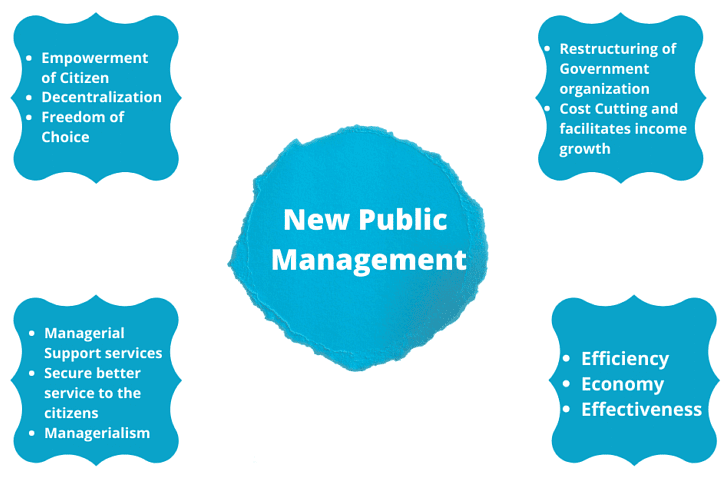New Public Management | Public Administration Optional for UPSC (Notes) PDF Download
| Table of contents |

|
| Introduction |

|
| Exponents of New Public Management |

|
| Origin of New Public Management |

|
| Principles of New Public Management |

|
| Features of New Public Management |

|
| Conclusion |

|
Introduction
New Public Management (NPM) is a management approach that seeks to enhance the efficiency and effectiveness of public sector organizations by implementing private sector management principles and practices. In this article, we explore the meaning of NPM, its 10 principles, and its key features. NPM emerged as a response to the need for more accountable and responsive public services, aiming to introduce market-oriented strategies and management methods. Let's delve into the details and understand the exponents, origin, principles, and features of NPM.
Exponents of New Public Management
Christopher Hood coined the term "New Public Management" in his book 'A Public Management for all Seasons?' in 1991. He described NPM as a fusion of new institutional economics and successive waves of business-type managerialism. Another significant contribution was the book 'Reinventing Government: How the Entrepreneurial Spirit is Transforming the Public Sector' by Osborne and Gaebler in 1992, which further expanded the concept of NPM.
Origin of New Public Management
To comprehend the origin of NPM, it is essential to examine the following key points:
- Weak Public Administration: The traditional government bureaucracies were often criticized for being slow, inefficient, and lacking accountability. The developmental public administration prevalent in developed countries from the 1960s onwards weakened due to factors such as corruption and opacity. These shortcomings highlighted the need for a new administrative system.
- Important Administrative Reforms in the West: Reforms influenced by the New Right philosophy, which emphasized the free market and reducing the role of government, emerged in Western countries. Margaret Thatcher and Ronald Reagan played pivotal roles in introducing these economic reforms. The need for a radical change in public administration led to the emergence of NPM.
- Minnowbrook Conference II (1988): The Minnowbrook Conference II, held in 1988, was another significant milestone for NPM. This conference analyzed the transformed circumstances of public administration under the influence of neoliberalism. The principles of de-bureaucratization, democratization, and decentralization emerged, further strengthening the path of NPM.
- Reinventing Government: Osborne and Gaebler's book 'Reinventing Government' outlines 10 features of the new government model, which align with the principles of NPM. These features emphasize citizen access to a variety of sources, empowerment, goal-oriented governance, prevention-focused approaches, and collaboration with non-governmental entities.
Principles of New Public Management
NPM is driven by 10 core principles that guide its implementation:
- Emphasis on Economy, Efficiency, and Effectiveness: NPM prioritizes economic principles and downplays excessive regulation, focusing on achieving efficiency and effectiveness in public sector management.
- Reorganization of Bureaucracy: To enhance performance and responsiveness, NPM advocates for the reorganization of bureaucratic structures into different agencies.
- Introduction of Competition: NPM promotes competition through quasi-market systems and contract arrangements, enabling diverse service providers to offer improved services.
- Cost Reduction and Income Growth: By reducing expenses and facilitating income growth, NPM aims to enhance financial sustainability in the public sector.
- Adoption of Private-Sector Management Styles: NPM emphasizes the application of private-sector management techniques to enhance operational effectiveness and service delivery.
- Managerial Transformation: In NPM, administrators evolve into managers, focusing on strategic decision-making and outcome-oriented approaches.
- Flexibility and Mobility: NPM encourages increased flexibility and mobility within organizational structures, personnel management, and working conditions to adapt to changing demands.
- Consumer Focus: NPM views citizens as consumers and emphasizes meeting their needs through improved service quality and choice.
- Participatory Management: NPM promotes decentralization and participatory decision-making processes, ensuring active engagement of stakeholders in governance.
- Multi-Sector Collaboration: NPM recognizes the importance of collaboration with government institutions, non-governmental organizations, and private corporations to address social challenges effectively.
Features of New Public Management
The implementation of NPM results in several key features that transform public administration:
- Citizen Empowerment: NPM empowers citizens by offering freedom of choice and access to quality services through healthy competition among service providers.
- Decentralization: NPM advocates for the decentralization of power, shifting from rigid bureaucracies to dynamic and flexible managerial support systems.
- Restructuring of Government Organizations or Sectors: NPM involves restructuring government organizations or sectors, dividing them into smaller units and assigning responsibilities to the private sector through contracts.
- Goal-Orientation: NPM focuses on achieving specific goals rather than adhering strictly to procedures and rules, emphasizing outcomes and results.
- Cost Cutting and Income Growth: By contracting out governmental sectors, NPM aims to reduce costs and maximize government income.
- Managerial Support Services: NPM prioritizes hiring the best talent from the market to provide citizens with high-quality services. Skill improvement through training programs is emphasized.
- Better Service to Citizens: NPM's ultimate objective is to deliver improved services to citizens, ensuring their needs are met effectively and efficiently.
Conclusion
New Public Management represents a paradigm shift from traditional public administration to a more efficient and customer-focused approach. By integrating private sector management principles, NPM seeks to enhance the responsiveness, cost-effectiveness, and accountability of public services. While NPM has its critics, its principles and features have significantly influenced the evolution of modern governance. As the world continues to evolve, finding the right balance between state power, market dynamics, and citizen welfare remains a crucial consideration.
|
58 videos|242 docs
|




















